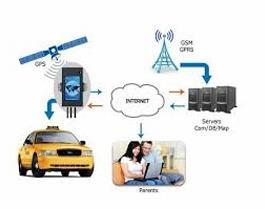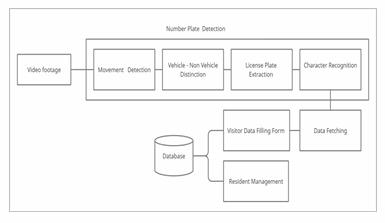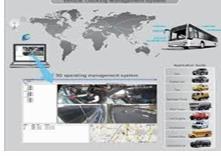
International Research Journal of Engineering and Technology (IRJET) e-ISSN: 2395-0056
Volume: 12 Issue: 01 | Jan 2024 www.irjet.net p-ISSN: 2395-0072


International Research Journal of Engineering and Technology (IRJET) e-ISSN: 2395-0056
Volume: 12 Issue: 01 | Jan 2024 www.irjet.net p-ISSN: 2395-0072
AVULA MAHA LAKSHMI1 , AABIROO ARSHAD2 , CHEJERALA SOWBHAGYA DEEPIKA 3
Assistant prof SHEIK JAMIL AHMED 4
1,2,3 Student, B. Tech (Computer Science and Engineering), Presidency University, Bangalore, India 4Assistant Professor, Computer Science and Engineering Department, Presidency University, Bangalore, India.
Abstract - This project presents a machine learning identify and authorize entry while keeping records of enabled surveillance system designed for real-time monitoring and tracking of vehicles in urban and residential environments. With rapid advancements in autonomoustechnologies,thereisanincreasingdemand for intelligent systems that can enhance public safety, streamline traffic management, and provide secure access control within private and public spaces. The proposedsystemleveragesdeeplearningalgorithmsfor vehicle detection, classification, and speed monitoring, whileutilizingIoTinfrastructuretoenableseamlessdata collection andremote access.
Key Words: Machine Learning, IoT, Surveillance System, Vehicle Tracking, Autonomous Technology, Deep Learning, Real-time Monitoring, Smart City, Traffic Management, License Plate Recognition, Predictive Analysis, AccessControl,SituationalAwareness.
The project is focused on developing an ML-enabled automatedsurveillanceandvisitormanagementsystemfor residentialsocieties.Theprimarygoalistointegrateimage processing and machine learning to automate the recognitionofvehicles,authenticateresidentsandvisitors, and manage access control seamlessly. With the growing demand for secure and efficient surveillance, this project aimstoprovideasolutionthatutilizesAutomaticNumber Plate Recognition (ANPR) and a backend database to visitors.Inrecentyears,advancementsinmachinelearning (ML) and Internet of Things (IoT) technologies have revolutionized the fields of surveillance and vehicle monitoring,especiallyinurbanenvironments.Societiesand cities are facing challenges related to traffic management, security, and real-time monitoring of vehicles to ensure safetyandefficiency.Traditionalsurveillancesystemshave limitationsintermsofscalability,real-timedataprocessing, and automated decision-making. However, with the integrationofMLalgorithmsandIoT-enableddevices,ithas become feasible to develop intelligent systems that can monitor, track, and analyze vehicle behavior in real time. These systems not only enhance security but also enable automatedspeedmonitoring,licenseplaterecognition,and
predictive analytics for traffic low and safety measures. Additionally, the system will be equipped with an of line modetoensureaccessibilityinremotelocations.
ML Enabled Surveillance System for Societies [1]:
Recent studies emphasis the role of IoT and machine learning in improving vehicle monitoring systems. These technologies enable real-time vehicle tracking and traffic violationdetection.Traditionalsystemslikespeedgunsare costlyandlimitedtosingle-lanemonitoring.Incontrast,IoTbased solutions are more scalable, cost-effective, and automated.Mobileappsenhancesecuritybyprovidingrealtimealertsanddataaccessforbothresidentsandsecurity personnel.However,theaffordabilityofthesesolutionsisa majorconsiderationforbroaderimplementation.
jimmy_21Vehicle Tracking System [2]:
TheproposedVehicleTrackingSystemintegratesGPS,GSM, and web-based technologies to offer a comprehensive solution for vehicle owners, facilitating real-time tracking and enhanced management capabilities. It utilizes an advancedGY-NEO6MV2GPSmodule,allowingforlocation accuracywithin10meters,whichisconsistentwithexisting systemsreviewedintheliterature.Thesystemarchitecture includesanIoTplatformbasedonArduino,alongwithaGSM module for communication. The web application is developedusingVue.jsforthefrontendandLaravelforthe backend,incorporatinguserauthentication,adashboardfor easymanagement,andtheabilitytotrackvehiclesviaSMS. Existing vehicle tracking systems frequently lack key features such as user management and tracking device management,whichtheproposedsystemaddresses.Overall, thisresearchprovidesadditionalfunctionalitiesthatmeet the contemporary needs of vehicle tracking and management,contributingvaluableinsightstothefield.
IoT Based Vehicle Monitoring System [3]:
The literature survey reviews various methodologies for vehicle tracking systems that utilize GPS and GSM technologies. One study proposes a public transport monitoringsolutionusingRaspberryPiandGPSantennasto trackvehiclelocations.AnotherfocusesonanArduino-based real-time tracking system designed for personal vehicle

International Research Journal of Engineering and Technology (IRJET) e-ISSN: 2395-0056
Volume: 12 Issue: 01 | Jan 2024 www.irjet.net p-ISSN: 2395-0072
security.OtherapproachesincludeembeddingGSMmodules for location updates via SMS and employing accident detectionsystemsthatautomaticallyalertauthorities.These studieshighlighttheevolvinglandscapeofvehicletracking solutions, emphasizing enhanced safety, efficient fleet management, and real-time monitoring capabilities. Collectively, they underscore the growing significance of integrated tracking systems in both commercial and personalapplications.
IoT-Enabled Vehicle Speed Monitoring System [4]:
Inthisresearchpaper,systemsprovidesignificantbenefits suchasenhancedfleetmanagement,improvedsafety,and real-timemonitoringcapabilities,enablingefficientrecovery of stolen vehicles and timely accident alerts. However, challenges remain, including privacy concerns due to continuous monitoring, potential signal interference in urban environments, and the reliance on technology that mayhindertraditionalnavigationskills.Overall,whilethe advancements in vehicle tracking offer considerable advantagesforsecurityandoperationalefficiency,theyalso necessitate careful consideration of the associated drawbacks to maximize their effectiveness in real-world applications.
Autonomous Vehicle implementation prediction [5]:
The Research paper examines the integration of GPS and GSMtechnologiesinvehicletrackingsystems,highlighting their effectiveness in enhancing fleet management, safety, and real-time monitoring. Studies demonstrate that these systems facilitate prompt recovery of stolen vehicles and improveresponsetimesinemergenciesthroughautomated alerts.However,challengessuchasprivacyissues,potential signalinterferenceinurbanenvironments,anddependency on technology are significant drawbacks. Overall, while advancements in vehicle monitoring greatly improve operationalefficiencyandsecurity,balancingthesebenefits withtheassociatedchallengesisessentialfortheireffective implementationinreal-worldscenarios.
In recent years, residential societies have increasingly sought out effective and affordable solutions to enhance security and streamline visitor management. Traditional surveillance systems often rely on manual processes and offer limited integration with intelligent monitoring capabilities.Thisprojectintroducesacost-effectivevehicle monitoring system tailored specifically for residential societies,focusingonaffordability,easeofdeployment,and intelligentfeatures.
The core innovation lies in the integration of Automatic NumberPlateRecognition(ANPR)technologywithavisitor management system, utilizing machine learning and computervisiontoautomatevehiclerecognitionandaccess control.Byleveragingpre-trainedmodelsandopen-source
tools like Django and OpenCV, the system can detect and recognizevehiclesinreal-time,authenticateresidents,and logvisitorentrieswithoutrequiringhighendhardware.This solution enables societies to maintain detailed visitor records, receive real-time alerts, and monitor entries efficiently through a centralized dashboard, all while minimizingoperationalcosts.
This approach presents a new paradigm in affordable, intelligent monitoring by addressing key challenges in conventional systems enhancing security, reducing dependency on manual verification, and providing a streamlinedprocessforresidentsandvisitorsalike.Witha focusonlow-costimplementationandeasyscalability,this system redefines the possibilities for residential security management.

The system would utilize cost-effective technology to monitor vehicles entering and exiting residential areas, ensuring residents' safety and optimizing parking space usage.Keyfeaturescouldinclude:
1. License Plate Recognition:Usecamerasequipped withimagerecognitiontoautomaticallyrecordthe licenseplatesofvehicles.Thiscouldbeintegrated withadatabasetotrackresidents'vehiclesversus visitors.
2. Real-Time Monitoring: Implement CCTV surveillancethatfeedsvideotocentralmonitoring system where security can oversee all vehicle activity.
3. Mobile App Integration:Allowresidentstoaccess the system through a mobile app where they can register their vehicles, receive notifications about parkingavailability,andreportsuspiciousactivities directlytothesecurityteam.
4. Automated Alerts: Set up automated alerts for unauthorizedaccessorvehiclesparkedinrestricted areas,enhancingsecuritymeasures.
5. Data Analytics:Usedatacollectedfromthesystem to analyze traffic patterns and optimize parking spaceallocation,potentiallyintegratingwithsmart citysolutions.

International Research Journal of Engineering and Technology (IRJET) e-ISSN: 2395-0056
Volume: 12 Issue: 01 | Jan 2024 www.irjet.net p-ISSN: 2395-0072

Fig-2: Block diagram of number plate detection
Implementation Considerations:
Cost-Effectiveness: Utilize open-source software forimageprocessinganddatamanagementtokeep costslow.
Scalability:Designthesystemtobescalablesoit can be expanded or modified as the needs of the residentialcommunityevolve.
Privacy Concerns: Ensure the system adheres to privacylawsandregulations,implementingrobust dataprotectionmeasures.
Web Module Imports:
DjangoandPythonlibrariesensurerobustbackend functionality, allowing for efficient data handling andserverresponses.
Integration with my site settings for email configurations simplifies managing application settings in one place, promoting consistency and easiermaintenance.
DeeplearningmodelsloadedfromJSONandtrained weights enable precise character recognition on license plates, enhancing the accuracy of vehicle identification.
Global Variables and Functions:
Model loadingand initializationat startup reduce the load time per request by keeping the models readyforinference.
Centralized Video path management streamlines theprocessoffetchinganddisplayingvideocontent relatedtosecurityfootageorvehiclemovements
Theprimaryobjectiveofthisconstructionsitemanagement project is to introduce a mobile application that revolutionizesthewayconstructionsitesaremanaged.The projectseekstostreamline andenhancesitemanagement processes, promoting efficiency, transparency, and communication among all stakeholders involved in a constructionproject.beendefinedintheabstract.
Key Functionalities:
1) Vehicle Monitoring:
Utilizes ANPR technology to identify vehiclesenteringorleavingthepremises.
Enhances security by automating vehicle checks and maintaining logs of all movements
2) User Authentication and Session Management:
Ensures that only authorized users can access the system, protecting sensitive residentdata.
Session-based authentication helps maintainuserstateandimprovessecurity.
3) Dynamic Content Management:
Residents and visitors can be added, updated,orremovedthroughuser-friendly webforms.
Automated email notifications keep residentsinformedaboutvisitorarrivalsor securityalerts.
4) Logging and Reporting:
Generates comprehensive logs of visitor activities, which are crucial for security auditsandcommunitymanagement.
The system automatically handles file attachments in emails, enhancing communicationeffectiveness
5) Error Handling and User Feedback:
Provides clear error messages and redirectsbasedonuseractions,improving theuserexperienceandsystemusability.
Robust form validation and handling prevent incorrect data entry and ensure dataintegrity.

Implementingacomprehensivevehiclemonitoringsystem for residential societies using the described Django web applicationentailsseveralchallengesthatmustbecarefully managed.Theseinclude:
1. Technical Complexity and Integration Issues:
ANPR Accuracy:Ensuringtheaccuracyof automatic number plate recognition

International Research Journal of Engineering and Technology (IRJET) e-ISSN: 2395-0056
Volume: 12 Issue: 01 | Jan 2024 www.irjet.net p-ISSN: 2395-0072
(ANPR) under different lighting conditions and with various vehicle speedsandangles.
System Integration: Integrating new technologieswithexistinginfrastructure without causing disruptions can be complex, particularly if the existing systemsareoutdated
2. Scalability and Performance:
Handling Large Volumes of Data:Asthe residentialcommunitygrows,thesystem must efficiently manage increased data from more vehicles and cameras, potentiallyslowingdowntheprocessing time.
Real-Time Processing: Thesystemmust process and analyze video data in realtime, which requires significant computational resources and efficient codingtoavoidlatency.
3. Security and Data Privacy:
Data Protection: Storing and processing residents' personal and vehicle data necessitates strict adherence to data protectionlaws,suchasGDPRorsimilar regulations.
Unauthorized Access: There is a risk of unauthorized access to sensitive data, whichrequiresrobustsecuritymeasures like encryption, secure authentication mechanisms,andregularsecurityaudits.
4. User Adoption and Interface Usability:
User Resistance: Residents might resist the adoption of new technologies, particularly if they feel it infringes on theirprivacyorcomplicatestheirroutine.
User Interface Design: Designing an intuitiveanduser-friendlyinterfacethat canbeeasilyusedbyresidentsofallages andtechnologicalproficiencylevels.
5. Maintenance and Support:
System Updates: Regular updates and maintenancearerequiredtoensurethe system's functionality, which involves additionalcostsandlogisticalplanning.
Technical Support: Providing ongoingtechnical support to address any issues residents or administrators may encounterwiththesystem.
Thisprojectprovidesaninnovativeandaffordableapproach to vehicle monitoring for residential societies, leveraging machine learning and image processing for real-time, automated recognition of vehicles and license plates. By eliminating the need for high-end hardware and manual
processes,thissolutionoffersacost-effectivealternativeto traditionalmonitoringsystemswhilesignificantlyenhancing security, accountability, and operational efficiency in residentialcommunities.
Wesincerelythankourguide,SheikJamilAhmed(assistant professor, Presidency university, Bangalore), for his guidance and support throughout this project. We also extendourgratitudetoPresidencyUniversityforproviding thenecessaryresourcesandencouragementtocompletethis work.
[1] PranavChauhan,SachinGupta,RohitArava,Sameer Nanivadekar, Vishal Badgujar. “ML Enabled “SurveillanceSystemforSocieties”
[2] ShaiUllahKhan,NoorAlam,SanaUllahJan,InSoo Koo. “IoT-Enabled Vehicle Speed Monitoring Systems.”
[3] Patel, A., Desai, k. Shah, R. Sharma. M” A Deep LearningApproachtoReal-TimeVehicleDetection andClassificationinsmartCities.”JournalofUrban Technology.
[4] Smith,J.,Lee,H.,&Wang,X."AI-DrivenAutonomous Surveillance Systems for Public Safety." International Journal of Computer Vision and Applications.
[5] Jain,R.,&Kumar,P.(2022)."EnhancingSecurityin Smart Residential Areas Using Machine Learning basedANPRSystems."SecurityandCommunication Networks.
[6] Khan, F., & Ali, A. (2021). "Review of Machine LearningAlgorithmsforSmartSurveillanceinIoT Environments."JournalofNetworkandComputer Applications.
[7] Chen,M.,Gonzalez,S.,Vasilakos,A.,Cao,H.,&Leung, V.C.M. (2017). "Body Area Networks: A Survey." Mobile Networks and Applications, focusing on wearablesensorsinresidentialsecurityscenarios.
[8] Li,X.,Zhao,Y.,&Rong,C.(2019)."CloudComputing Solutions for Smart Urban Surveillance Systems Using Machine Learning and IoT Sensing." Future GenerationComputerSystems.
[9] Singh, D., & Reddy, B. (2020). "IoT and AI-based ApproachesforHomeSecurityandAutomationin SmartResidentialSocieties."InternationalJournal ofSmartHome.

International Research Journal of Engineering and Technology (IRJET) e-ISSN: 2395-0056
Volume: 12 Issue: 01 | Jan 2024 www.irjet.net p-ISSN: 2395-0072
[10] Zhou,W.,Jia,Y.,Peng,A.,Zhang,Y.,&Liu,P.(2018). "TheImpactofArtificialIntelligenceonSurveillance inPublicandPrivateSectors."InternationalJournal ofSecurityandItsApplications.
[11] Morgan, Y. L. (2019). "Real-Time License Plate RecognitionUsingDeepNeuralNetworks."Journal ofReal-TimeImageProcessing.
[12] Farooq,M.S.,Riaz,S.,Abid,A.,Umar,A.I.,&Zikri,Y. B.(2020)."SecureandEfficientDataAcquisitionin SmartCitiesThroughMobileIoTSensing."Sensors.
[13] Wang, C., & Lai, J. H. (2021). "Machine Learning Algorithms for Smart Data Analysis in Internet of Things Environment: Taxonomies and Research Trends."Symmetry.
[14] He, D., Zeadally, S., Kumar, N., & Lee, J.-H. (2021). "DesignandImplementationofPrivacyPreserving Surveillance Systems Using Blockchain in Smart Cities."SustainableCitiesandSociety.
[15] Aggarwal, C. C. (2020). "Outlier Analysis." In Data Mining. Springer, Cham. (Particularly useful for detectingunusualpatternsinsurveillancedata.)
[16] Zhao,D.,Ma,H.,&Lee,V.C.S.(2019)."AReviewof Computational Approaches in Smart Urban Surveillance."Journal ofAmbientIntelligenceand HumanizedComputing.